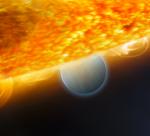Hubble finds carbon dioxide on exoplanet
Posted: Wed, Dec 10, 2008, 8:12 AM ET (1312 GMT)
 Astronomers using the Hubble Space Telescope have detected evidence of carbon dioxide in the atmosphere of an extrasolar planet, a step forward in the search for evidence of life. Hubble's near infrared camera and spectrometer studied light from HD 189733b, a "hot Jupiter" extrasolar planet closely orbiting a star 63 light-years away. Because of the orientation of the planet's orbit, the planet passes behind the star as seen from Earth, allowing astronomers to subtract light from just the star itself from times the star and planet are both in view, thus allowing astronomers to measure the infrared light emitted from the planet's hot interior. That light contained the spectral signature of carbon dioxide absorbing specific wavelengths of light as it passed through the planet's atmosphere. While this planet is thought to be far too hot to support life, but demonstrates the ability to detect this gas for other, more promising planets.
Astronomers using the Hubble Space Telescope have detected evidence of carbon dioxide in the atmosphere of an extrasolar planet, a step forward in the search for evidence of life. Hubble's near infrared camera and spectrometer studied light from HD 189733b, a "hot Jupiter" extrasolar planet closely orbiting a star 63 light-years away. Because of the orientation of the planet's orbit, the planet passes behind the star as seen from Earth, allowing astronomers to subtract light from just the star itself from times the star and planet are both in view, thus allowing astronomers to measure the infrared light emitted from the planet's hot interior. That light contained the spectral signature of carbon dioxide absorbing specific wavelengths of light as it passed through the planet's atmosphere. While this planet is thought to be far too hot to support life, but demonstrates the ability to detect this gas for other, more promising planets.
 Astronomers using the Hubble Space Telescope have detected evidence of carbon dioxide in the atmosphere of an extrasolar planet, a step forward in the search for evidence of life. Hubble's near infrared camera and spectrometer studied light from HD 189733b, a "hot Jupiter" extrasolar planet closely orbiting a star 63 light-years away. Because of the orientation of the planet's orbit, the planet passes behind the star as seen from Earth, allowing astronomers to subtract light from just the star itself from times the star and planet are both in view, thus allowing astronomers to measure the infrared light emitted from the planet's hot interior. That light contained the spectral signature of carbon dioxide absorbing specific wavelengths of light as it passed through the planet's atmosphere. While this planet is thought to be far too hot to support life, but demonstrates the ability to detect this gas for other, more promising planets.
Astronomers using the Hubble Space Telescope have detected evidence of carbon dioxide in the atmosphere of an extrasolar planet, a step forward in the search for evidence of life. Hubble's near infrared camera and spectrometer studied light from HD 189733b, a "hot Jupiter" extrasolar planet closely orbiting a star 63 light-years away. Because of the orientation of the planet's orbit, the planet passes behind the star as seen from Earth, allowing astronomers to subtract light from just the star itself from times the star and planet are both in view, thus allowing astronomers to measure the infrared light emitted from the planet's hot interior. That light contained the spectral signature of carbon dioxide absorbing specific wavelengths of light as it passed through the planet's atmosphere. While this planet is thought to be far too hot to support life, but demonstrates the ability to detect this gas for other, more promising planets.
Related Links:
| <<previous article | next article>> |
|
news in brief
|
|
|
|
news links
|
|
Thursday, January 8
Four Vendors Are Set To Build New LEO Missile-Tracking Constellation
Aviation Week — 6:36 am ET (1136 GMT) Global Orbital Launch Rate Jumped 25% In 2025
Aviation Week — 6:36 am ET (1136 GMT) First Vulcan Launch Announced In New Era For ULA
Aviation Week — 6:36 am ET (1136 GMT) TPS evaluations taking place at Starbase on next two Ships to fly
NasaSpaceFlight.com — 6:34 am ET (1134 GMT) Vandenberg Announces Plan for New ‘Super-Heavy’ Launch Site
Santa Barbara (CA) Independent — 6:34 am ET (1134 GMT) |